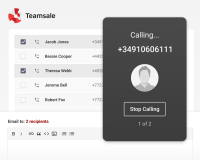Call center can be rightfully called the face of the company, as for many clients it is where the first interaction with the business takes place. Because of that, the right call center organization is an important and responsible task.
And we’ll tell you how to organize it on a budget and in only five steps.
Spoiler alert: you won’t even need a separate space.
1. Buy equipment
A pleasant surprise here – you don’t need a big investment. You only need a computer or a laptop (the simplest configuration will do) and a headset connected to it.
Prices on headset vary significantly, from $10-12 and up to several hundreds of USD per set.
We recommend not to save up on the equipment for your call center, particularly on headsets. Better quality (hence more expensive) models have a noise-cancelling feature, which will allow you to place all operators in one space. So, with quality equipment you can save on square feet and partitions.
2. Buy a virtual number
Now that you have the equipment and you have the employees, you need to make and receive calls. For that you will need virtual numbers.
You can choose a number from any country or city; but remember – people are more likely to take a call from (and make a call to) their own region. If your business is not just local, but offers sales and support nation-wide, we suggest connecting a toll-free number which is free for everyone in the country to call. We offer 800 numbers in 80 countries of the world.
All virtual numbers are multichannel, meaning they have several incoming lines (so your operators can take calls simultaneously). As for outgoing channels (concurrent outbound calls from one number), their number depends on the price plan you choose. If you have more than 20 employees that mostly make outgoing calls, we recommend connecting Corporation price plan (price plans have regional division).
Most importantly, all incoming calls to virtual numbers (except the ones to toll-free numbers) accepted via the internet are completely free.
3. Enabling voice menu (IVR)
Numbers are connected, now on to setting up free Cloud PBX.
That very auto informant, that allows users to navigate around your services. Correct voice menu settings will allow your callers to not waste time on explaining their call purpose and your managers to communicate with “warm” clientele.
4. Work hours settings
During work hours all calls will go straight to operators routed through your IVR. The rest of time calls can either be forwarded to a personal mobile number (if these calls need immediate response), or to the answering machine. In this case calls will be recorded, and operators can call back later.
5. Additional settings
Enabling call recordings
Recordings provide you with the most useful tool in business – data. With them you can control operators’ work, improve your service and use the information for dispute resolution. This feature can be enabled in, literally, one click.
Integrating PBX with CRM systems
This is an essential point for creating an effective call center. Such integration will let operators call in one click, will automatically collect statistics and systemize client base including their contacts.
There are numerous CRM systems on the market, but we recommend taking a look at our Teamsale CRM. It is fully integrated with Cloud PBX, does not have a limit on concurrent users, allows to plan tasks and control their fulfilment.
It is free and perfectly fits the budget model.
Enabling additional features
Everything described above is just a set of basic features. With the help of API you can develop and implement everything you need. For instance, integration with messengers for call notifications.
As you can see, creating a fully functioning and quality call center is not a hard task and can require minimal investments. In this era of global internet you do not even need a large space or to be physically present in a certain city.
You can work remotely with no damage to the quality.
 Calls
Calls
 Phone numbers
Phone numbers
 eSIM for traveling
eSIM for traveling
 SMS
SMS
 Business Phone System
Business Phone System
 Speech analytics
Speech analytics
 Callback button
Callback button
 Video conferencing
Video conferencing
 Click to call button
Click to call button
 VoIP for Business
VoIP for Business
 Become a partner
Become a partner
 Integrations
Integrations
 For whom
For whom
 Setup guides
Setup guides
 FAQ
FAQ
 Online chat
Online chat
 Contact support
Contact support
 Blog
Blog












